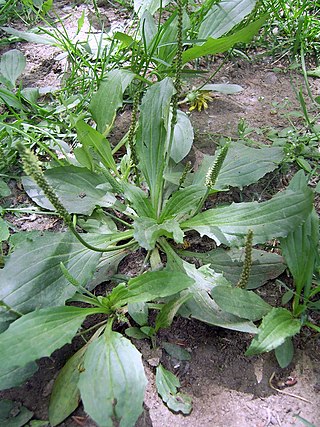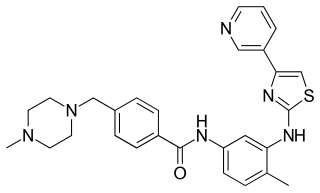Related Research Articles
Antisense therapy is a form of treatment that uses antisense oligonucleotides (ASOs) to target messenger RNA (mRNA). ASOs are capable of altering mRNA expression through a variety of mechanisms, including ribonuclease H mediated decay of the pre-mRNA, direct steric blockage, and exon content modulation through splicing site binding on pre-mRNA. Several ASOs have been approved in the United States, the European Union, and elsewhere.

Traditional Korean medicine refers to the forms of traditional medicine practiced in Korea.

Peripherin is a type III intermediate filament protein expressed mainly in neurons of the peripheral nervous system. It is also found in neurons of the central nervous system that have projections toward peripheral structures, such as spinal motor neurons. Its size, structure, and sequence/location of protein motifs is similar to other type III intermediate filament proteins such as desmin, vimentin and glial fibrillary acidic protein. Like these proteins, peripherin can self-assemble to form homopolymeric filamentous networks, but it can also heteropolymerize with neurofilaments in several neuronal types. This protein in humans is encoded by the PRPH gene. Peripherin is thought to play a role in neurite elongation during development and axonal regeneration after injury, but its exact function is unknown. It is also associated with some of the major neuropathologies that characterize amyotropic lateral sclerosis (ALS), but despite extensive research into how neurofilaments and peripherin contribute to ALS, their role in this disease is still unidentified.

A neurodegenerative disease is caused by the progressive loss of structure or function of neurons, in the process known as neurodegeneration. Such neuronal damage may ultimately involve cell death. Neurodegenerative diseases include amyotrophic lateral sclerosis, multiple sclerosis, Parkinson's disease, Alzheimer's disease, Huntington's disease, multiple system atrophy, and prion diseases. Neurodegeneration can be found in the brain at many different levels of neuronal circuitry, ranging from molecular to systemic. Because there is no known way to reverse the progressive degeneration of neurons, these diseases are considered to be incurable; however research has shown that the two major contributing factors to neurodegeneration are oxidative stress and inflammation. Biomedical research has revealed many similarities between these diseases at the subcellular level, including atypical protein assemblies and induced cell death. These similarities suggest that therapeutic advances against one neurodegenerative disease might ameliorate other diseases as well.

Plantago asiatica, is a self-fertile, perennial flowering plant of genus Plantago. The plant is native to East Asia. It grows really well in disturbed areas like roadsides or even dirt roads. It is valued for its use in folk medicine and it also can be used in cooking.

Ursolic acid, is a pentacyclic triterpenoid identified in the epicuticular waxes of apples as early as 1920 and widely found in the peels of fruits, as well as in herbs and spices like rosemary and thyme.

Superoxide dismutase [Cu-Zn] also known as superoxide dismutase 1 or hSod1 is an enzyme that in humans is encoded by the SOD1 gene, located on chromosome 21. SOD1 is one of three human superoxide dismutases. It is implicated in apoptosis, familial amyotrophic lateral sclerosis and Parkinson's disease.

Profilin-1 is a protein that in humans is encoded by the PFN1 gene.

VGF or VGF nerve growth factor inducible is a secreted protein and neuropeptide precursor that may play a role in regulating energy homeostasis, metabolism and synaptic plasticity. The protein was first discovered in 1985 by Levi et al. in an experiment with PC12 cells and its name is non-acronymic. VGF gene encodes a precursor which is divided by proteolysis to polypeptides of different mass, which have a variety of functions, the best studied of which are the roles of TLQP-21 in the control of appetite and inflammation, and TLQP-62 as well as AQEE-30 in regulating depression-like behaviors and memory. The expression of VGF and VGF-derived peptides is detected in a subset of neurons in the central and peripheral nervous systems and specific populations of endocrine cells in the adenohypophysis, adrenal medulla, gastrointestinal tract, and pancreas. VGF expression is induced by NGF, CREB and BDNF and regulated by neurotrophin-3. Physical exercise significantly increases VGF expression in mice hippocampal tissue and upregulates a neurotrophic signaling cascade thought to underlie the action of antidepressants.

Cornus officinalis, the Japanese cornel or Japanese cornelian cherry, is a species of flowering plant in the dogwood family Cornaceae. Despite its name, it is native to China and Korea as well as Japan. It is not to be confused with C. mas, which is also known as the Cornelian cherry. It is not closely related to the true cherries of the genus Prunus.

Amyotrophic lateral sclerosis (ALS), also known as motor neurone disease (MND) or Lou Gehrig's disease, is a rare neurodegenerative disease that results in the progressive loss of motor neurons that control voluntary muscles. ALS is the most common form of the motor neuron diseases. Early symptoms of ALS include stiff muscles, muscle twitches, gradual increasing weakness, and muscle wasting. Limb-onset ALS begins with weakness in the arms or legs, while bulbar-onset ALS begins with difficulty in speaking or swallowing. Around half of people with ALS develop at least mild difficulties with thinking and behavior, and about 15% develop frontotemporal dementia. Motor neuron loss continues until the abilities to eat, speak, move, or (finally) breathe are lost.
Jaseng Hospital of Korean Medicine is a network of hospitals for non-invasive treatment of spine and joint disorders in South Korea. It was designated as a 'Spine Specialized Oriental Medical Hospital' by the Korea Ministry of Health and also designated as a 'Health Tour' hospital for foreigners by the Korean Health Industry Development Institute (KHIDI).

Masitinib is a tyrosine-kinase inhibitor used in the treatment of mast cell tumours in animals, specifically dogs. Since its introduction in November 2008 it has been distributed under the commercial name Masivet. It has been available in Europe since the second part of 2009. Masitinib has been studied for several human conditions including melanoma, multiple myeloma, gastrointestinal cancer, pancreatic cancer, Alzheimer disease, multiple sclerosis, rheumatoid arthritis, mastocytosis, amyotrophic lateral sclerosis and COVID-19.

Celastrol (tripterine) is a chemical compound isolated from the root extracts of Tripterygium wilfordii and Tripterygium regelii. Celastrol is a pentacyclic nortriterpen quinone and belongs to the family of quinone methides. In mice, celastrol is an NR4A1 agonist that alleviates inflammation and induces autophagy. Also in mice, celastrol increase expression of IL1R1, which is the receptor for the cytokine interleukin-1 (IL-1). IL1R1 knock-out mice exposed to celastrol exhibit no leptin-sensitizing or anti-obesity effect.
Neuroinflammation is inflammation of the nervous tissue. It may be initiated in response to a variety of cues, including infection, traumatic brain injury, toxic metabolites, or autoimmunity. In the central nervous system (CNS), including the brain and spinal cord, microglia are the resident innate immune cells that are activated in response to these cues. The CNS is typically an immunologically privileged site because peripheral immune cells are generally blocked by the blood–brain barrier (BBB), a specialized structure composed of astrocytes and endothelial cells. However, circulating peripheral immune cells may surpass a compromised BBB and encounter neurons and glial cells expressing major histocompatibility complex molecules, perpetuating the immune response. Although the response is initiated to protect the central nervous system from the infectious agent, the effect may be toxic and widespread inflammation as well as further migration of leukocytes through the blood–brain barrier may occur.

Dendrobium plicatile is an Asian orchid species, a member of the genus Dendobium. It was formerly described as Flickingeria fimbriata.
Coiled-coil-helix-coiled-coil-helix domain-containing protein 10, mitochondrial, also known as Protein N27C7-4 is a protein that in humans is encoded by the CHCHD10 gene.
There are more than 25 genes known to be associated with amyotrophic lateral sclerosis (ALS) as of June 2018, which collectively account for about 70% of cases of familial ALS (fALS) and 10% of cases of sporadic ALS (sALS). About 5–10% of cases of ALS are directly inherited. Overall, first-degree relatives of an individual with ALS have a 1% risk of developing ALS. ALS has an oligogenic mode of inheritance, meaning that mutations in two or more genes are required to cause disease.
Research on amyotrophic lateral sclerosis (ALS) has focused on animal models of the disease, its mechanisms, ways to diagnose and track it, and treatments.
References
- 1 2 Park, Sunjung; Yang, Eun Jin (2018-06-21). "Anti-Inflammatory Effect of Gamisoyo-San in an Animal Model of Amyotrophic Lateral Sclerosis". Evidence-Based Complementary and Alternative Medicine. 2018: 1–6. doi:10.1155/2018/8580152. ISSN 1741-427X. PMC 6032819 . PMID 30034501.
- ↑ Jin, Seong Eun; Kim, Ohn Soon; Yoo, Sae-Rom; Seo, Chang-Seob; Kim, Yeji; Shin, Hyeun-Kyoo; Jeong, Soo-Jin (2016-07-15). "Anti-inflammatory effect and action mechanisms of traditional herbal formula Gamisoyo-san in RAW 264.7 macrophages". BMC Complementary and Alternative Medicine. 16 (1): 219. doi:10.1186/s12906-016-1197-7. ISSN 1472-6882. PMC 4946171 . PMID 27422559.
- ↑ Shin, Seung Jae; Kim, Doeun; Kim, Ji Sun; Kim, Iksung; Lee, Jong Rok; Kim, Sang Chan; Kim, Byung Joo (2018-07-25). "Effects of Gamisoyo-San Decoction, a Traditional Chinese Medicine, on Gastrointestinal Motility". Gastroenterologia. 98 (4): 231–237. doi:10.1159/000489455. ISSN 0301-164X.
- ↑ Cai, MuDan; Yang, Eun Jin (2018-06-25). "Gamisoyo-San Ameliorates Neuroinflammation in the Spinal Cord of hSOD1G93A Transgenic Mice". Mediators of Inflammation. 2018: e5897817. doi:10.1155/2018/5897817. ISSN 0962-9351. PMC 6036813 . PMID 30046279.